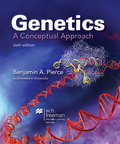
a.
To determine:
The reason for accepting or rejecting the statement “Transcription does not take place” when bacteria are raised at an elevated temperature if rho is not functional at a higher temperature and the strain of bacteria possesses a mutation in a gene that encodes the rho subunit.
Introduction:
Rho-factor is a type of prokaryotic protein which causes termination of the transcription process when the RNA forms a hairpin loop structure. Rho-factor displaces RNA polymerase and stops the transcription process.
b.
To determine:
The reason for accepting or rejecting the statement “All RNA molecules are shorter than normal” when bacteria are raised at an elevated temperature if rho is not functional at a higher temperature and the strain of bacteria possesses a mutation in a gene that encodes the rho subunit.
Introduction:
Rho-factor is a type of prokaryotic protein which causes termination of the transcription process when the RNA forms a hairpin loop structure. Rho-factor displaces RNA polymerase and stops the transcription process.
c.
Introduction:
Rho-factor is a type of prokaryotic protein which causes termination of the transcription process when the RNA forms a hairpin loop structure. Rho-factor displaces RNA polymerase and stops the transcription process.
To determine:
The reason for accepting or rejecting the statement “All RNA molecules are longer than normal” when bacteria are raised at an elevated temperature if rho is not functional at a higher temperature and the strain of bacteria possesses a mutation in a gene that encodes the rho subunit.
d.
To determine:
The reason for accepting or rejecting the statement “Some RNA molecules are longer than normal” when bacteria are raised at an elevated temperature if rho is not functional at a higher temperature and the strain of bacteria possesses a mutation in a gene that encodes the rho subunit.
Introduction:
Rho-factor is a type of prokaryotic protein which causes termination of the transcription process when the RNA forms a hairpin loop structure. Rho-factor displaces RNA polymerase and stops the transcription process.
e.
To determine:
The reason for accepting or rejecting the statement “RNA is copied from both DNA strands” when bacteria are raised at an elevated temperature if rho is not functional at a higher temperature and the strain of bacteria possesses a mutation in a gene that encodes the rho subunit.
Introduction:
Rho-factor is a type of prokaryotic protein which causes termination of the transcription process when the RNA forms a hairpin loop structure. Rho-factor displaces RNA polymerase and stops the transcription process.
Want to see the full answer?
Check out a sample textbook solution
Chapter 13 Solutions
Genetics: A Conceptual Approach
- Molecular Biology Explain/discuss how “slow stop” and “quick/fast stop” mutants wereused to identify different protein involved in DNA replication in E. coli.arrow_forwardMolecular Biology Question A gene that codes for a protein was removed from a eukaryotic cell and inserted into a prokaryotic cell. Although the gene was successfully transcribed and translated, it produced a different protein than it produced in the eukaryotic cell. What is the most likely explanation?arrow_forwardMolecular Biology LIST three characteristics of origins of replicationarrow_forward
- Molecular Biology Question Please help. Thank you For E coli DNA polymerase III, give the structure and function of the b-clamp sub-complex. Describe how the structure of this sub-complex is important for it’s function.arrow_forwardMolecular Biology LIST three characteristics of DNA Polymerasesarrow_forwardMolecular Biology RNA polymerase core enzyme structure contains what subunits? To form holo enzyme, sigma factor is added to core. What is the name of the structure formed? Give the detailed structure of sigma factor and the function of eachdomain. Please help. Thank youarrow_forward
- Molecular Biology You have a single bacterial cell whose DNA is labelled with radioactiveC14. After 5 rounds of cell division, how may cells will contain radioactive DNA? Please help. Thank youarrow_forward1. Explain the structure and properties of atoms and chemical bonds (especially how they relate to DNA and proteins). Also add some pictures.arrow_forward1. In the Sentinel Cell DNA integrity is preserved through nanoscopic helicase-coordinated repair, while lipids in the membrane are fortified to resist environmental mutagens. also provide pictures for this question.arrow_forward
- Explain the structure and properties of atoms and chemical bonds (especially how they relate to DNA and proteins). Also add some pictures.arrow_forwardIn the Sentinel Cell DNA integrity is preserved through nanoscopic helicase-coordinated repair, while lipids in the membrane are fortified to resist environmental mutagens. also provide pictures for this question.arrow_forward1. Explain how genetic information is stored, copied, transferred, and expressed. Also add some pictures for this question.arrow_forward
 Human Anatomy & Physiology (11th Edition)BiologyISBN:9780134580999Author:Elaine N. Marieb, Katja N. HoehnPublisher:PEARSON
Human Anatomy & Physiology (11th Edition)BiologyISBN:9780134580999Author:Elaine N. Marieb, Katja N. HoehnPublisher:PEARSON Biology 2eBiologyISBN:9781947172517Author:Matthew Douglas, Jung Choi, Mary Ann ClarkPublisher:OpenStax
Biology 2eBiologyISBN:9781947172517Author:Matthew Douglas, Jung Choi, Mary Ann ClarkPublisher:OpenStax Anatomy & PhysiologyBiologyISBN:9781259398629Author:McKinley, Michael P., O'loughlin, Valerie Dean, Bidle, Theresa StouterPublisher:Mcgraw Hill Education,
Anatomy & PhysiologyBiologyISBN:9781259398629Author:McKinley, Michael P., O'loughlin, Valerie Dean, Bidle, Theresa StouterPublisher:Mcgraw Hill Education, Molecular Biology of the Cell (Sixth Edition)BiologyISBN:9780815344322Author:Bruce Alberts, Alexander D. Johnson, Julian Lewis, David Morgan, Martin Raff, Keith Roberts, Peter WalterPublisher:W. W. Norton & Company
Molecular Biology of the Cell (Sixth Edition)BiologyISBN:9780815344322Author:Bruce Alberts, Alexander D. Johnson, Julian Lewis, David Morgan, Martin Raff, Keith Roberts, Peter WalterPublisher:W. W. Norton & Company Laboratory Manual For Human Anatomy & PhysiologyBiologyISBN:9781260159363Author:Martin, Terry R., Prentice-craver, CynthiaPublisher:McGraw-Hill Publishing Co.
Laboratory Manual For Human Anatomy & PhysiologyBiologyISBN:9781260159363Author:Martin, Terry R., Prentice-craver, CynthiaPublisher:McGraw-Hill Publishing Co. Inquiry Into Life (16th Edition)BiologyISBN:9781260231700Author:Sylvia S. Mader, Michael WindelspechtPublisher:McGraw Hill Education
Inquiry Into Life (16th Edition)BiologyISBN:9781260231700Author:Sylvia S. Mader, Michael WindelspechtPublisher:McGraw Hill Education





